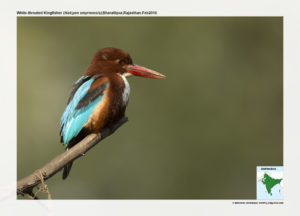
White-breasted Kingfisher Halcyon smyrnensis
Etymology:
- Halcyon : Greekmythical bird which nested on the sea. It was loved by the gods, who calmed the waves whilst it incubated and raised its young.
- Smyrnensis : From Smyrna in Turkey
Vernacular Names: Baluchistan: Aspi chidok, Sind: Dalel, Hindi: Safed-chati Kilkila, Kourilla, Sans: Chandrakant meenrankk, H.P: Neela machhrala, Pun: Wadda machhera, Bi: Tanki, Ben: Sandabuk machhranga, Ass: Masroka, Cachar: Dao natu gophu, Guj: Kalkaliyo, Safedchati kalkaliyo, Mar: Khandya, Pandharya Chaticha Dhivar Ori: For kingfishers – Machharanka, Ta: Vichuli, Meenkotti, Te: Lakmuka, Buchegadu, Mal: Ponman, Kan: Rajamatsi, Sinh: Pilihuduwa
Distribution in India: Wide spread Resident.
Description: Size of 27-28 cm. It is a medium-sized kingfisher with distinctive dark chestnut, blue and white plumage. The male of nominate race has dark chestnut head, flanks and belly, white throat and breast, blue back, wings and tail; lesser wing-coverts chestnut, median coverts dark blue; white patch at base of black primaries obvious in flight; bill red; iris dark brown, orbital skin red; legs and feet dusky red. The female is slightly paler head and belly. The juvenile is duller, breast with fine dark scallops. The nominate race is found in North West India ; race fusca (Uttarakhand to West Bengal and Peninsular India) is smaller, slightly darker, less green tinge in blues, bluer above and deeper brown below than nominate; race perpulchra ( North East India) is smaller and has paler underparts.
Habitat: It is found in dams, ponds, canals, creeks, swamps, mudflats, beaches with coconut palms and trees, mangrove edges, palm swamps, oil palm plantations, farmland, rice fields, large gardens, roadside trees, light industrial sites, bamboo-forest, dry deciduous forest. Usually avoids dense forest except for clearings. It is found between lowland and 2300 m.
Food Habits:It eats mole-crickets , crickets and grasshoppers, earwigs , cockroaches , bug, beetles, mantises , termites, winged ants, moths and caterpillars; small scorpions , centipedes, snails, crabs and crustaceans ,earthworms ,fish, frogs and toads, lizards, chameleons, snakes , birds, voles, mice, and squirrels. It typical is a sit-and-wait predator, spends long periods on perch above ground, with just head bobbing or tail wagging, before diving head first at 45° angle into deep water, or landing feet first in puddle or on ground; can hover for a moment over water before snatching prey. While still on ground or on returning to perch, will batter prey before swallowing it; can take up to 30 minutes before food swallowed.
Breeding Habits: They breed in Jan-Aug in India. They are monogamous. During breeding they call from prominent perch, bird sitting upright and periodically spreading wings to show white wing patches; in aerial display flies 50–60 m up with much calling, then spirals down. They nest is a tunnel usually in earthen bank of ditch, stream, river, pond or road cutting, sometimes in termitarium, rock crevice, tree or mud hole, rarely in haystack. The nest-chamber is up to 15–23 cm wide and 13 cm high, at end of inclined tunnel 30–150 cm long and 6–8 cm in diameter. They lay a clutch 4–7 white eggs. Both parents incubate for a period 18–20 days. The hatching is over 3–4 days; both parents feed chicks. The fledging period is 26–27 days. The adults feed young for one month after fledging.